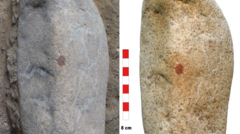Research highlights a significant leap in understanding Neanderthal cognitive abilities and their capacity for symbolic thinking.
Ancient Fingerprint Unveils Neanderthal Artistic Expression

Ancient Fingerprint Unveils Neanderthal Artistic Expression
Discovery in Spain indicates Neanderthals may have created art 43,000 years ago.
The world of archaeology has been shaken by a remarkable discovery in Spain, where scientists have uncovered what they believe to be the oldest complete human fingerprint on a rock, potentially hinting at Neanderthal artistry. This finding centers around a stone, thought to resemble a human face, that dates back approximately 43,000 years, with indications that a Neanderthal man used red pigment to paint a nose on the pebble at the San Lázaro rock shelter in Segovia.
The significance of the dot's precise placement has prompted researchers to propose that this evidence showcases the Neanderthals' capability for “symbolic behaviour”—suggesting that they possessed the ability for abstract thought. Co-author of the study, María de Andrés-Herrero, emphasized the implications of this find in a BBC interview, noting the excavation of the site had been ongoing for five years. They discovered the pebble beneath 1.5 meters of sediment deposited by Neanderthal communities.
Prof de Andrés-Herrero recounted the initial disbelief when they first examined the stone, which stood out among other artifacts due to its distinct red spot that resembled a facial feature. After thorough investigation, including collaboration with Spain's scientific police for multi-spectrum analysis, the research team confirmed that the dot was indeed a pigment, alongside capturing a fingerprint believed to belong to an adult male.
Although the researchers faced challenges in definitively attributing the fingerprint to a Neanderthal, co-author David Álvarez Alonso acknowledged that the lack of comparable Neanderthal references complicates conclusions. In a public news briefing, Spanish official Gonzalo Santonja proclaimed the pebble to be the oldest known painted portable object within Europe, and the only piece of art known to be created by Neanderthals.
Prof de Andrés-Herrero stated that the findings significantly contribute to discussions regarding Neanderthals' symbolic capabilities, marking the first known instance of a pigment-marked artifact identified within an archaeological framework. The context of the fingerprint discovery, being non-utilitarian, further suggests that the red dot served an artistic intent.
Researchers surmise that a Neanderthal may have picked up the striking stone, possibly drawn to its unique fissures, and deliberately marked it with ochre pigment. This evidence indicates that the material did not occur naturally within the shelter, thus bolstering the argument that the mark was intentional. The comprehensive study is detailed in the journal *Archaeological and Anthropological Sciences*, asserting the extraordinary nature of the pebble as a conceivable form of portable art.
The significance of the dot's precise placement has prompted researchers to propose that this evidence showcases the Neanderthals' capability for “symbolic behaviour”—suggesting that they possessed the ability for abstract thought. Co-author of the study, María de Andrés-Herrero, emphasized the implications of this find in a BBC interview, noting the excavation of the site had been ongoing for five years. They discovered the pebble beneath 1.5 meters of sediment deposited by Neanderthal communities.
Prof de Andrés-Herrero recounted the initial disbelief when they first examined the stone, which stood out among other artifacts due to its distinct red spot that resembled a facial feature. After thorough investigation, including collaboration with Spain's scientific police for multi-spectrum analysis, the research team confirmed that the dot was indeed a pigment, alongside capturing a fingerprint believed to belong to an adult male.
Although the researchers faced challenges in definitively attributing the fingerprint to a Neanderthal, co-author David Álvarez Alonso acknowledged that the lack of comparable Neanderthal references complicates conclusions. In a public news briefing, Spanish official Gonzalo Santonja proclaimed the pebble to be the oldest known painted portable object within Europe, and the only piece of art known to be created by Neanderthals.
Prof de Andrés-Herrero stated that the findings significantly contribute to discussions regarding Neanderthals' symbolic capabilities, marking the first known instance of a pigment-marked artifact identified within an archaeological framework. The context of the fingerprint discovery, being non-utilitarian, further suggests that the red dot served an artistic intent.
Researchers surmise that a Neanderthal may have picked up the striking stone, possibly drawn to its unique fissures, and deliberately marked it with ochre pigment. This evidence indicates that the material did not occur naturally within the shelter, thus bolstering the argument that the mark was intentional. The comprehensive study is detailed in the journal *Archaeological and Anthropological Sciences*, asserting the extraordinary nature of the pebble as a conceivable form of portable art.





















